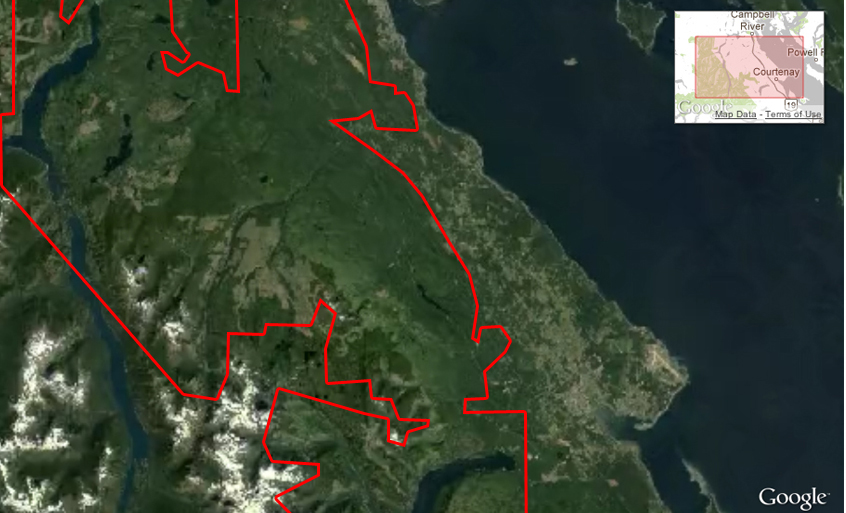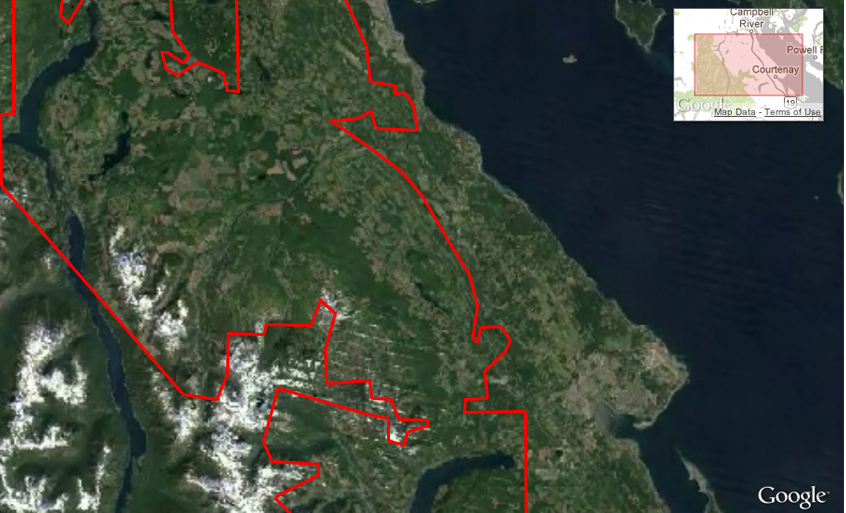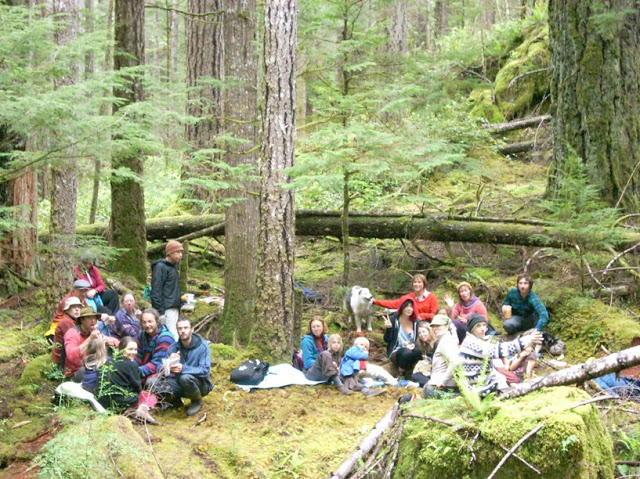In a universe parallel to the one Rod Bealing describes in “Public Attention for Private Forests” (Silviculture Magazine, Spring 2013), the communities adjacent to lands regulated by the Private Managed Forest Land Act aren’t hearing “Howdy, neighbour.” They’re hearing, “Please look the other way while we rip the heart out of your tourism industry, ruin your drinking watershed, close down opportunities for permanent forest jobs, deliver the final blow to declining fish runs, convert forest land into real estate developments and intensify the impacts that climate change will have on your lives. We’re allowed. It’s private land.”
Public money creates a public duty
Since 1947 the province has subsidized ’managed’ forest land with a lower property tax assessments On Cortes Island, for example, I paid about $62 in taxes in 2011 for each of my 20 inland acres. Island Timberlands (IT) paid between $5 and $6 for of its inland acres a few kilometres away. On a land base of 1,800 Ha over a period of twenty years, this results in a comparative $4.7 million property tax savings for IT. Even with the lower per acre value of large parcels, this is a multimillion dollar tax break. What is the public getting for these tax breaks? In Regional Districts such as the Cowichan Valley, the timber companies’ lack of direct contribution to community coffers or indirect contribution through permanent sustainable forestry or value added manufacturing jobs has become a political issue.
The history of private managed forest lands is one of public largesse. The Big Three timber companies (TimberWest, Island Timberlands and Western Forest Products) hold land that first became private in exchange for a public service, building a railway. [i] The original social contract for Tree Farm Licenses (the logging rights to public lands) was return that land to management under Crown regulation. But the timber companies very profitably broke that social contract- and the provincial government let them – when they released their private lands from TFLs. In 2003, the Liberals further delinked private lands from public obligations with the “fox watching the hen coop” provisions of the Private Forest Land Management Act, a “results based” and essentially voluntary regulatory regime.
The Big Three may do extremely little for the people of the province in return for these gifts, but they certainly donate a lot to the BC Liberals who deregulated them. Between 2008 and 2011, Brookfield Asset Management (parent company of Island Timberlands) donated $95,000; Western Forest Products $72,500; Weyerhaeuser $35,500; and TimberWest $87,000. [ii] “A partnership between forest owners and the provincial government,” indeed. But who protects the citizens of B.C.?
The PMFLA
Doug Harris of the UBC Faculty of Law has described the PMFLA as “a highly flexible, industry‐friendly Act, which does not prohibit activity on forestland, but provides incentives to forestland owners who comply with its provisions.” Regarding values such as drinking water, soil, fisheries and critical habitat, the PMFLA has vague “management objectives” with no specific requirements. It’s a perfect piece of legislation in that way: it contains the key words that allow timber companies and their allies to claim that important public goods are “regulated”, but it is empty of meaningful obligations. In fact, it explicitly excludes the need to consider cumulative effects from activities on adjacent lands.
Nor is the PMFLA reasonably enforced. The PMFLC has made only 11 determinations over the past six years. [iii] Only five of those were based on logging practices, the failure to retain a stream side buffer. Three determinations found fault on the part of the timber company but only one of these resulted in remediation and a penalty. Even in that one, according to a contemporaneous report by John Werring, an aquatic habitat specialist at the David Suzuki Foundation, the PMFLC minimized substantial concerns in its determination that a violation occurred.
The results of a “results based” regulatory regime
According to the Canadian Centre for Policy Alternatives, [iv] the results of the PFLMA include: logging at twice the sustainable rate; ever younger trees logged; all of Island Timberland’s Douglas fir “merchantable” stock slated for depletion in 25 years; loss of jobs because trees are no longer delivered to coastal mills; huge increase in raw log exports from B.C.’s coast, 62 per cent of which come from private forestlands; and tens of thousands of hectares of private forestland being readied for sale as real estate developments or other “higher and better uses.”


These photos show the the private managed forest land base between Campbell River and Comox in 1984 and 2012. This level of logging is representative of all the E&N railway grant lands of SE Vancouver Island. For more comparisons by year, go to http://world.time.com/timelapse/ For a map of PMFLA lands, go to http://www.pmflc.ca/maps/vi.pdf
The new B.C. economy: Tourism
According to NDP MLA Bill Routley, [v] under the BC Liberals, 35,000 forest jobs were lost and 17 manufacturing plants closed on Vancouver Island alone. Six million cubic metres of raw logs were exported in 2012. The sight of a single employee operating a feller buncher far up a deserted road could make any B.C. citizen weep – or, for that matter, watching the five or so container ships that leave Vancouver Island each month, full of raw logs. [vi]
The Liberals may have given the timber companies what they want, but the result is that communities have little or no stake in timber company operations. Instead, they depend on the hinterlands as a playground that attracts tourists from western B.C.’s burgeoning cities and, indeed, the world. Tourism, not timber has become the forests’ biggest contribution to local economies.
In the Discovery Islands, tourism operators have joined forces to make their case to the province. According to their group:
- In 2008, B.C.’s tourism revenue exceeded its forestry revenues;
- In the Discovery Islands and Bute Inlet, less than 11% regional GDP comes from logging, while over 60 tourism operators that employ over 650 people;
- Tourists come to the area to watch the southern grizzly bear populations; to play on the well known tidal rapids; enjoy the rich marine life including whales and fishing; and explore the 16 B.C. Marine Parks in addition to the land based B.C. Parks and Regional Parks. [vii]
Vancouver Island touts itself as an eco-tourism destination and people spend money to see wilderness, not clear cuts. It’s not only citizens that protest logging now. It is towns like Port Alberni and businesses like the Discovery Islands tourism operators.
Drinking water
The PMFLA provides virtually no protection to drinking watersheds and the PMFLC provides virtually no enforcement. Vancouver Island has suffered extensive watershed destabilization and degradation with severe impacts on both drinking water supplies and fish habitat. Timber companies have stripped uplands of forest cover and rapid spring runoff creates flood damage followed by accentuated summer drought. Montane uplands have poor regeneration and the hydrological effects are long lasting.
Shawnigan Lake residents, who take their drinking water from the lake, have spent a decade fighting to protect it from the cumulative effects of logging, much of it on private lands owned by Island Timberlands and TimberWest. [viii] According to one citizen, about 80% of the second growth on private lands has been logged over the last twenty years resulting in a loss of capacity for the surrounding forest to filter the water going into Shawnigan Lake.
The relationship between logging and degraded drinking water supplies can be less obvious than the Shawnigan Lake situation, but no less real. Vancouver Island and the Gulf Islands are at high risk for water shortages due to changes in the climate. Industrial style logging compounds this risk. In Cowichan Valley, citizens hold TimberWest’s logging at least partially responsible for the Cowichan River nearly running dry last year. [ix] On Cortes Island, Island Timberlands owns the lands that feed into the island’s central groundwater recharging swamp. The PMFLA doesn’t even prevent degradation to Shawnigan Lake and it won’t require a precautionary principle to a small community’s water supply. With climate change we depend on the protection of forests now more than ever to store and filter water.
One incident that reveals how well foxes guard henhouses occurred when the PMFLC failed to pursue a known violation until a citizen group sought enforcement. PMFLC found fault, rescinded the fine, and did not pursue any other responsible party. In 2008 a $35,000 fine assessed by the PMFLC was rescinded when TimberWest asserted that it did not instruct its contractor to cut all the trees along one side of stream in the Comox Valley drinking watershed. Yet no fine was assessed against that contractor either. The entirely denuded stream bank was self-reported by TimberWest and confirmed in a fly-over by the PMFLC but not investigated until the B.C. Tap Water Alliance filed a formal complaint a year and a half later.[x]
Fish habitat
Bealing’s assertion in the previous Silviculture Magazine Article that independent audits show that the fish habitat “value” has been protected to the same degree on private land as on public land suggests only that both are severely degraded. Impaired freshwater fish habitat, combined with increased ocean mortality from climate change, continues to drive the severe decline in fish stocks. [xi]
The Greater Georgia Basin Steelhead Recovery Plan website shows that nearly all the steelhead populations of Vancouver Island are of “extreme conservation concern,” and private land logging is listed as the major culprit in a substantial number of streams.
In Comox Valley citizens state they face a half million dollar bill for flood remediation as a result of TimberWest’s logging of private managed forest lands. Local fishery and watershed restoration groups (not the timber companies that caused the problems) work to remediate the downstream consequences of logging in their headwaters. [xii]
Forest land into real estate developments
Timber companies can now cash out their various de facto public subsidies by selling lands for residential development, a so called “higher and better use” that is vastly more profitable to shareholders in the short term. These low elevation lands converted to development have some of the best conditions for growing trees.
According to the CCPA, in 2007 TimberWest designated close to 17% of their 322,000 hectares as better suited for other uses. Island Timberlands’ parent company, Brookfield Infrastructure Partners, told shareholders that about 5% of IT’s 256,136 hectares are suitable for higher and better uses.
Timber companies pay no exit fee to compensate for their incredibly low property taxes if the land has been in the managed forest land class for more than 15 years.[xiii] Remember how Island Timberlands pays something close to 10% of what I pay in taxes? It can turn around and sell its land at premium development prices without the province recouping any of the hundreds of millions of dollars in foregone tax revenue.
Timber companies have received huge substantial windfalls in recent years when the provincial government has allowed them to remove private lands from the Tree Farm Licences that were granted on the condition that private as well as public lands remain in the TFL. Estimates of Weyerhaeuser’s windfall in 2004 from Minister Mike de Jong range between $200-800 million. When Minister Rich Coleman approved WFP removing 2,500 hectares of land in the Sooke-Jordan River area from its TFL for residential subdivision, Auditor General John Doyle found a clear lack of regard for the public interest.
“Independent” certification
As long as the timber companies can pretend that Sustainable Forestry Initiative (SFI) certification responds to community or ecological values, they will remain in their alternate universe. Recently Forest Ethics, pointed out that SFI is an industry-conceived scheme that protects industrial forestry, not forests. In particular, SFI does not require the longer rotations and less intensive methods that would provide quality wood to sustain value added manufacturing that would lock up carbon in durable heartwood, and replenish the habitat that is currently being diminished.
The bubble has popped
Brookfield Infrastructure Partners (BIP) is negotiating to sell its 25% share of Island Timberlands for $170 million, a deal expected to close in 2013. BIP found IT couldn’t meet its target of a 12-15% return on equity. The target was based on an unrealistic expectation: that communities will acquiesce to industrial logging followed by rezoning for residential use. They will not.
Communities are banding together for strength, such as the citizens of Roberts Creek, the Sunshine Coast, Qualicum Beach, Cortes Island and Port Alberni who demand that Island Timberlands incorporate community aspirations into their operations. Markets campaigns are going forward, to help consumers link forest products to socially inoperable lands. Pensioners are awakening to the fact that their pension funds (e.g. PSP and bcIMC) own the companies that are decimating Vancouver Island’s forests and they are demanding reform.
Climate Change
Bealing’s article ignores how industrial logging intensifies the serious risks to water and food security imposed by climate change. First, it’s a major contributor: logging in BC releases more carbon emissions than the tailpipes of BC’s cars.[xiv] Second, it increases spring flooding and summer drought. Climate models[xv] predict that Vancouver Island will have more water shortages. Warmer, wetter winters will reduce snowpack. Cool, wet springs will increase spring floods. Warmer, dryer summers will mean regular droughts with drinking water and agricultural water shortages. Timber companies don’t account for these profound changes and they put community water supplies at risk.

Whoa, neighbour!
If the author of “Public attention to private forests” really wants to know why so many British Columbians are so angry with private forestry, he might consider how patronizingly phony his “Howdy, neighbour!” sounds to actual neighbours. The Big Three export raw logs (and jobs), use machine-intensive logging practices and remove their land from TFLs so they can “log and flog” it in lots. These practices hurt tourism jobs, future forest economies, drinking watersheds, fish habitat and ecosystems. They also destroy the resilience we will need as climate change intensifies the flood/drought cycle that many communities already face.
Timber companies have sought and received public largesse. In exchange, they have a public responsibility to conduct truly sustainable logging that maintains forests as healthy ecosystems and supports tourism jobs, long term forest employment, fish habitat, drinking water supplies and the integrity of community landscapes. British Columbians are justifiably angry that private forestry so flagrantly and consistently breaches its social contract. Demanding rights but refusing responsibilities goes by many names. “Neighbourly” certainly isn’t one of them.
Carrie Saxifrage owns land on Cortes Island where she has advocated for ecosystem based forestry on private and Crown forest lands for nearly two decades. She reports on sustainability issues for thevancouverobserver.com.
- Log in to post comments
